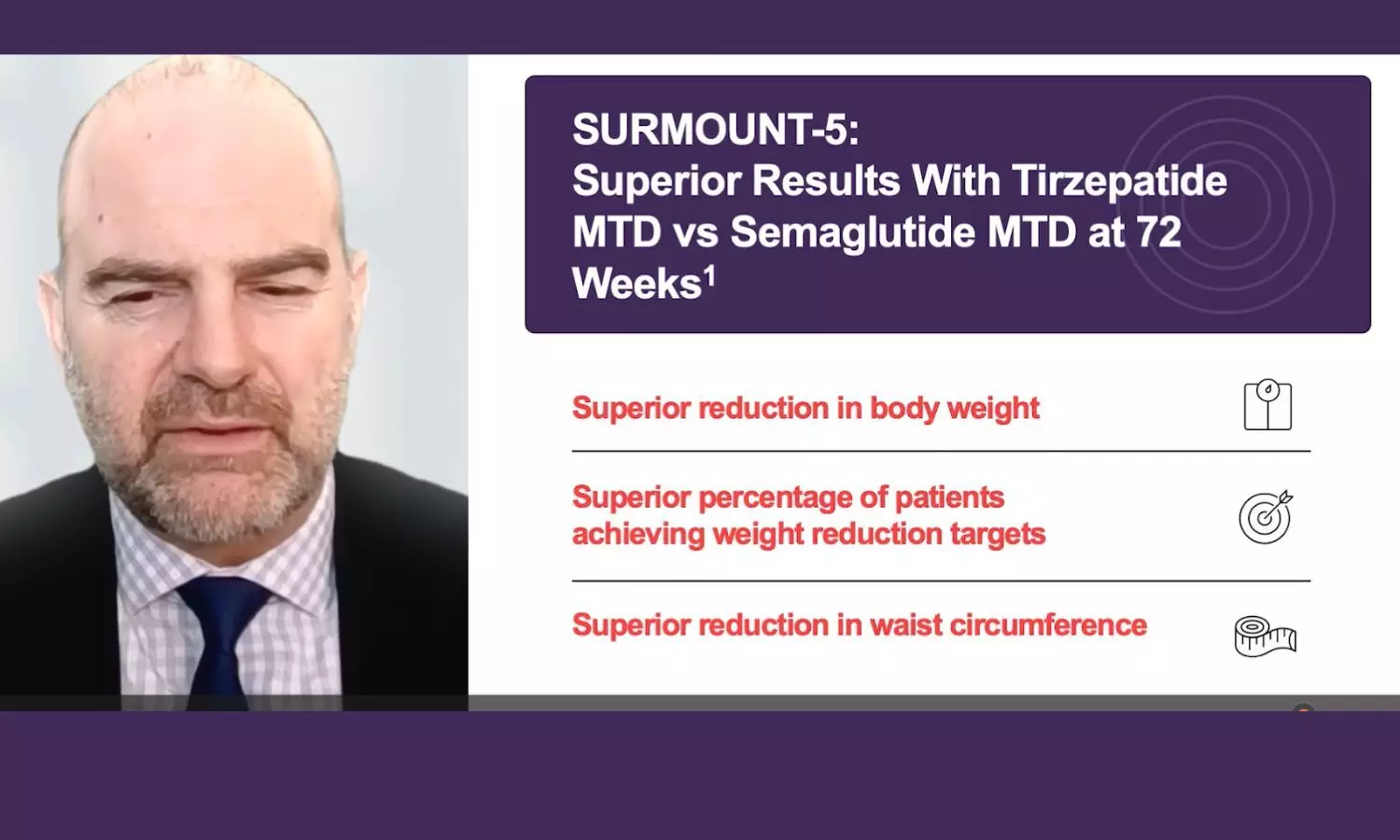US childhood vaccination rates fall again as exemptions set another record
Powered by WPeMatico
Powered by WPeMatico
Powered by WPeMatico
Powered by WPeMatico
Powered by WPeMatico
Powered by WPeMatico
Powered by WPeMatico

SURMOUNT-5 was a 72-week, Phase 3b, multicenter, randomized, open-label,
comparator-controlled
study that evaluated the efficacy and safety of tirzepatide 15 mg or MTD (10 mg or 15 mg)
compared
with semaglutide 2.4 mg or MTD (1.7 mg or 2.4 mg) in adults with obesity or overweight with at least one
obesity-related complication, excluding diabetes. All participants received lifestyle intervention with
reduced-calorie diet and increased physical activity.
The primary
endpoint was the mean percentage change in body weight from baseline to Week 72. Tirzepatide
showed
superior mean body weight reduction (-21.6%) compared to
semaglutide (-15.4%). Key secondary endpoints included achieving ≥10%, ≥15%, ≥20%, and ≥25% weight
reduction—1 in 3 patients on tirzepatide achieved ≥25% weight loss vs
1 in
5 with semaglutide.
Tirzepatide also led to greater reductions in waist circumference, systolic and diastolic BP, HbA1c,
triglycerides,
and non-HDL cholesterol. The most common adverse
events were gastrointestinal, mostly mild to moderate.
Overall, tirzepatide demonstrated superior efficacy in weight and metabolic
improvements
compared to semaglutide in adults with obesity or overweight and comorbidities.
THERAPEUTIC INDICATION1:
Type 2 diabetes mellitus
MOUNJARO® is indicated for the treatment of adults with insufficiently
controlled type 2 diabetes mellitus as an adjunct to diet and exercise
• as monotherapy when metformin is considered inappropriate due to
intolerance or contraindications
• in addition to other medicinal products for the treatment of
diabetes.
For study results with respect to combinations, effects on glycaemic
control and the populations studied, see sections 4.4, 4.5 and 5.1.
Weight management
MOUNJARO® is indicated as an adjunct to a reduced-calorie diet and
increased physical activity for weight management, including weight loss and weight maintenance,
in adults with an initial Body Mass Index (BMI) of
• ≥ 30 kg/m² (obesity) or
• ≥ 27 kg/m² to < 30 kg/m² (overweight) in the presence of at least one
weight-related comorbid condition (e.g., hypertension, dyslipidaemia, obstructive sleep apnoea,
cardiovascular disease, prediabetes, or type 2 diabetes mellitus).
*SURMOUNT-5 was a 72-week, Phase 3b, multicenter, randomized,
parallel-arm, open-label, comparator-controlled study that evaluated the efficacy and safety of
Tirzepatide 15 mg or MTD (10 mg or 15 mg) compared with Semaglutide 2.4 mg or MTD (1.7 mg or 2.4
mg) in adults with Obesity (BMI ≥30 kg/m²) or overweight (BMI ≥27 kg/m²) with at least one
Obesity-related complication (e.g., hypertension, dyslipidemia), excluding diabetes.** The study
included a 2-week screening period. Mean baseline weight was 112.7 kg for Tirzepatide MTD (10 mg
or 15 mg) and 113.4 kg for Semaglutide MTD (1.7 mg or 2.4 mg). Participants in both the
Tirzepatide and Semaglutide treatment arms received lifestyle intervention, including a
reduced-calorie diet and increased physical activity. Treatments were administered QW
subcutaneously as an adjunct to a reduced-calorie diet and increased physical
activity1.
For Tirzepatide Prescribing Information, please check: https://image.mc.lilly.com/lib/fe9312747462077971/m/1/0e04e051-5fa2-445b-850d-4f09ef66d35e.pdf
Efficacy estimand, mixed model for repeated measures (MMRM) analysis,
modified intent-to-treat (mITT) population, (efficacy analysis set). Limitations of an
open-label study may be related to a bias in evaluation of the outcomes, efficacy and/or safety,
and analysis was not tested against a placebo-controlled comparison group1.
SURMOUNT-1 Phase 3 double-blind, randomized, placebo-controlled trial in
adults with Obesity (BMI of ≥30 kg/m²) or with Overweight (BMI of ≥27 kg/m²) with at least one
Obesity-related complication (e.g.,hypertension, dyslipidemia), excluding T2D. All participants
received lifestyle interventions, including a reduced-calorie diet and increased physical
activity.** All patients were randomly assigned in a 1:1:1:1 ratio to receive placebo, or
tirzepatide at a dose of 5 mg, 10 mg, or 15 mg as an adjunct to lifestyle
intervention4
¶p<0.001 vs baseline.
Mean % change in weight vs baseline (co-primary end point) at 72 weeks was -16.0% and -21.4% for
the 5 mg and 10 mg doses, respectively. Mean % change in weight vs placebo at 72 weeks was
-13.5%, -18.9%, and -20.1% for the 5 mg, 10 mg, and 15 mg doses, respectively (p<0.001 vs
placebo, adjusted for multiplicity). Mean kg change in weight vs baseline at 72 weeks was -16.1
kg and -22.2 kg for the 5 mg and 10 mg doses, respectively. Mean kg change in weight vs placebo
at 72 weeks was -13.8 kg, -19.8 kg, and -21.2 kg for the 5 mg, 10 mg, and 15 mg doses,
respectively (p<0.001 vs placebo, not adjusted for multiplicity). 2,4
# Adverse reaction development was not an endpoint for this study. Data
presented here should not be used to make inferences.
**”Obesity-related complications” are used as synonymic to “weight-related
complications and /or comorbidities”.
REFERENCES
1. Louis J. Aronne, M.D., et al. Tirzepatide as Compared with Semaglutide
for the Treatment of Obesity, N Engl J Med. 2025; doi: 10.1056/NEJMoa2416394
2. Mounjaro® (tirzepatide), India Prescribing Information. Updated March
2025.
3. Fisman EZ, Tenenbaum A. Cardiovasc Diabetol. 2021;20(1):225.
4. Jastrebo_ AM, et al. N Engl J Med. 2022;387(3):205–16.
Disclaimer:
This material (including any link) is intended solely for the use of the
recipient(s) and may contain confidential information. Any unauthorized review, use, disclosure,
copying, or distribution is strictly prohibited. If you are not the intended recipient, please
notify the sender immediately and destroy all copies of the material. The information provided
in this section is intended solely for the use of registered medical practitioner. This material
is being provided to healthcare professionals for their guidance and use. Nothing on this
website/microsite/material should be construed as giving medical advice or making
recommendations regarding any health-related decision or action.
Mounjaro®, KwikPen® and Lilly are registered trademarks of Eli Lilly and
Company. To be sold by retail under prescription of Endocrinologist or Internal Medicine
Specialists only. For adverse events and safety reporting, please reach out to: mailbox_in-gps@lilly.comFor any additional information related to Lilly products, please reach
out to: queries_in-medinfo@lilly.com. For further Information about Lilly and Lilly products please contact
us at the below address: Plot 92, Sector 32 Gurgaon, Haryana, 122001 India Ph.:
+91-124-4753000/01 | www.lilly.com/in.
PP-TR-IN-0580 VoD SM-5 | 29th July 2025
Eli Lilly and Company. All rights
reserved.
Powered by WPeMatico

According to a new research study, sleep impairment, particularly poor sleep quality, short sleep duration, and daytime dysfunction is significantly associated with increased diabetes distress in adults with type 2 diabetes, negatively impacting both disease management and mental well-being. The study was published in Diabetic Medicine journal by Hilde K. R. Riise and colleagues.
Diabetes distress is the emotional burden and frustration that individuals with diabetes can experience when attempting to control their disease. It differs from clinical depression but is linked to worse outcomes, such as diminished self-care and poor glycemic regulation. Sleep disturbances, also prevalent in individuals with T2D, have been suspected to contribute to heightened psychological stress. To investigate this, researchers employed answers to the HUNT4 sleep questionnaire, which gathered information on sleep problems such as snoring, sleep apnea, difficulty in falling asleep, nocturnal awakenings, early morning waking, excessive daytime sleepiness due to poor sleep, and restless legs. Diabetes distress was measured with the established PAID-5 questionnaire.
This cross-sectional study examined data on 1,954 adults with T2D who answered the HUNT4 survey. Sleep-related items were taken from the tested sleeping HUNT-Questionnaire, and the participants also indicated the average daily number of hours spent sleeping. Distress due to diabetes was assessed by the PAID-5 scale. Multivariate linear regression models were used to estimate the relationship of different sleep issues and distress scores, controlling for demographic, clinical, and mental health covariates. Prevalence rates and 95% confidence intervals were computed for each sleep impairment group.
Results
The findings revealed a distinct and uniform pattern: individuals who reported sleep impairments had greater diabetes distress scores.
Participants who slept ≤7 hours/night had an increased distress score: B = 0.6 (95% CI 0.2, 0.9).
Snoring correlated with increased distress: B = 0.6 (95% CI 0.1, 1.1).
They had a significantly larger increase in distress scores: B = 1.4 (95% CI 0.8, 2.2).
Waking up at night was also significantly associated: B = 1.1 (95% CI 0.6, 1.6).
Early morning waking had the same relationship: B = 1.2 (95% CI 0.7, 1.8).
The largest increase in distress was reported by those who had difficulty functioning during the day because they weren’t sleeping well: B = 2.6 (95% CI 1.7, 3.6).
Restless legs were also associated with distress: B = 0.8 (95% CI 0.2, 1.3).
These findings indicate that even ubiquitous and frequently-neglected sleep issues can have a very significant impact on the emotional load of T2D sufferers.
This research concluded that various forms of sleep impairment were all strongly related to greater diabetes distress levels in patients with type 2 diabetes. These findings emphasize the urgent importance of integrating sleep evaluation and treatment into overall diabetes care, given the potential for improving sleep health to be a major strategy for lowering diabetes-associated emotional distress.
Reference:
Riise HKR, Haugstvedt A, Igland J, et al. Diabetes distress and sleep impairment in type 2 diabetes: A population-based cross-sectional study-The HUNT Study, Norway. Diabet Med. Published online July 25, 2025. doi:10.1111/dme.70106
Powered by WPeMatico

A recent study involving 19,388 participants identified the platelet-to-high-density lipoprotein ratio (PHR) as a promising biomarker for gastrointestinal (GI) cancer risk. Individuals in the highest PHR quartile faced a 3.09-fold increased risk of GI cancers, with stronger associations seen in older adults, males, and obese individuals. A dose-response relationship was observed at PHR values of 3.2 and 4.5.
Gastrointestinal (GI) cancers, including gastric, colorectal, and esophageal cancers, pose a significant global health burden. Despite advancements in diagnostic tools, early detection remains challenging, particularly in low-resource settings. Emerging evidence highlights the platelet-to-high-density lipoprotein ratio (PHR) as a novel biomarker integrating systemic inflammation and lipid metabolism. However, its association with GI cancer risk remains underexplored. This study utilized data from the National Health and Nutrition Examination Survey (NHANES) from 2010 to 2018, comprising 19,388 participants, including 230 with GI cancers. PHR was calculated as the ratio of platelet count to high-density lipoprotein cholesterol levels and categorized into quartiles. Weighted logistic regression models, restricted cubic spline analysis, and subgroup analyses were employed to evaluate the association between PHR and GI cancer risk, adjusting for demographic, socioeconomic, lifestyle, and clinical factors. Results: Elevated PHR was independently associated with an increased risk of GI cancers. Participants in the highest PHR quartile exhibited a significantly higher risk (adjusted OR = 3.09; 95% CI: 2.16-4.43) compared to the lowest quartile. A dose-response relationship was observed, with two critical inflection points at PHR values of 3.2 and 4.5. Subgroup analyses revealed stronger associations among older adults, males, and obese individuals. The findings suggest that PHR may reflect the dynamic balance of systemic inflammation and lipid metabolism, contributing to tumorigenesis. This study identifies PHR as a promising, cost-effective biomarker for early detection and risk stratification of GI cancers. Its integration into screening programs could improve precision medicine strategies by identifying high-risk individuals for early intervention. Further longitudinal and mechanistic studies are warranted to confirm these findings and explore the underlying biological mechanisms.
Reference:
Tong Y, Lou X. Platelet-to-high-density lipoprotein ratio (PHR) as a predictive biomarker for gastrointestinal cancers: evidence from NHANES. BMC Gastroenterol. 2025 Apr 27;25(1):302. doi: 10.1186/s12876-025-03860-9. PMID: 40289098; PMCID: PMC12036308.
Keywords:
Tong Y, Lou X. Platelet-to-high-density, lipoprotein, ratio, (PHR), predictive, biomarker, gastrointestinal cancers, evidence, NHANES, BMC Gastroenterology, Cancer screening; Dose-response relationship; Gastrointestinal cancers; Lipid metabolism; NHANES; Platelet-to-high-density lipoprotein ratio (PHR).
Powered by WPeMatico

A large-scale prospective study has found a significant link between high consumption of ultraprocessed foods and an increased risk of Parkinson’s disease. Researchers followed over 120,000 participants from the UK Biobank for 10.5 years and observed that diets rich in ultraprocessed foods were associated with a higher likelihood of developing prodromal Parkinson’s, incident Parkinson’s disease, and even Parkinson’s-related mortality (Grosso et al., 2025). Ultraprocessed foods — including packaged snacks, ready-to-eat meals, processed meats, and sugary beverages — are typically high in additives, refined sugars, saturated fats, and sodium. While these foods have already been linked to a range of health concerns, including obesity, diabetes, and dementia, this study adds new weight to concerns about their neurological impact.
Researchers controlled for lifestyle, genetic, and socioeconomic factors and still found a strong association between high ultraprocessed food intake and increased risk of Parkinson’s disease, particularly in men. The study also found that individuals with the highest consumption levels had up to a 50% increased risk of Parkinson’s-related death compared to those with the lowest intake. ultraprocessed foods, Parkinson’s disease, UK Biobank study, neurological risk, brain health, neurodegeneration, Parkinson’s mortality, dementia diet link, prospective cohort study, diet and brainThese findings suggest that dietary habits could play a key role in the development and progression of neurodegenerative diseases. While the study does not establish direct causation, it highlights the need for further investigation and public health measures that encourage diets rich in whole foods, fruits, vegetables, and healthy fats.
Keywords: ultraprocessed foods, Parkinson’s disease, UK Biobank study, neurological risk, brain health, neurodegeneration, Parkinson’s mortality, dementia diet link, prospective cohort study, diet and brain
Powered by WPeMatico
